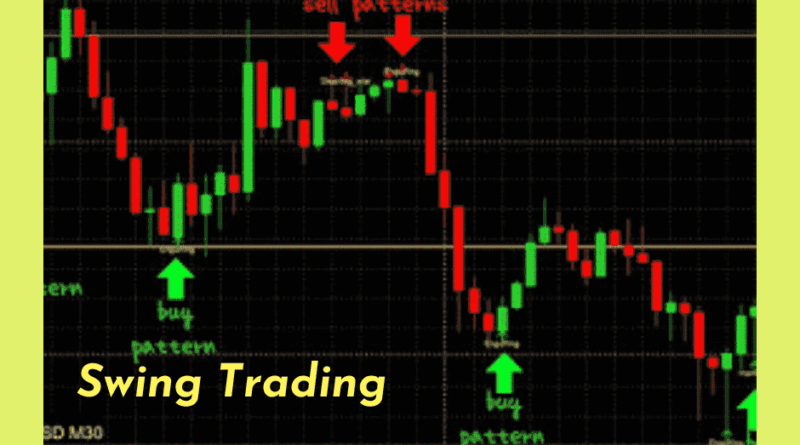Swing Trading: Capturing Market Momentum for Substantial Gains
Introduction
In the dynamic world of financial markets, where opportunities arise and subside in the blink of an eye, mastering the art of trading is a pursuit that demands precision, strategy, and adaptability.
Among the various trading styles that traders employ, swing trading stands as a bridge between the lightning-fast realm of day trading and the more patient approach of long-term investing.
What is Swing Trading?
Swing trading is a trading strategy, where traders seek to capitalize on short- to medium-term price movements within an asset’s overall trend.
Unlike day traders who aim to profit from intraday price fluctuations or long-term investors who hold positions for extended periods, swing traders typically hold positions for several days to a few weeks.
The primary goal of swing trading is to capture price “swings” or fluctuations that occur as a market trend unfolds. Swing traders often utilize technical analysis, charts, indicators, and patterns to identify potential entry and exit points. They focus on both upward and downward price movements, aiming to profit from market volatility.
Essential Tools for Swing Traders
Making informed decisions and spotting potential trade opportunities in the complex realm of swing trading requires reliable tools and indicators.
Moving Averages:
Moving averages are fundamental tools that smooth out price data over a specified period, helping traders identify trends and potential reversal points. Moving averages can be categorized into simple moving averages (SMA) and exponential moving averages (EMA). Swing traders often use the crossover of shorter-term and longer-term moving averages as signals for potential entry and exit points.
Relative Strength Index (RSI):
The RSI is a momentum oscillator that monitors how quickly and dramatically prices move. Ranging from 0 to 100, the RSI helps traders identify overbought and oversold conditions in a market, indicating potential reversals. A reading above 70 might suggest overbought conditions, while a reading below 30 might indicate oversold conditions.
MACD (Moving Average Convergence Divergence):
The MACD indicator is a flexible tool that blends moving averages to spot probable trend changes. It comprises two lines: a MACD line and a signal line. Crossovers between these lines can signal momentum shifts and potential buy-or-sell opportunities.
Bollinger Bands:
Bollinger Bands consist of a central moving average surrounded by upper and lower bands that represent volatility levels. When the price moves close to the upper band, it might indicate overbought conditions, while a price approaching the lower band could signify oversold conditions. Bollinger Bands can also help traders identify potential breakouts or trends.
Fibonacci Retracement:
Fibonacci retracement levels are horizontal lines drawn on a chart to identify potential support and resistance levels based on the Fibonacci sequence. Swing traders use these levels to anticipate potential price reversals during retracements within a trend.
Candlestick Patterns:
Candlestick patterns offer insights into price movements and potential trend reversals. Patterns like doji, hammer, and engulfing can indicate indecision, potential bullish reversals, or bearish reversals, respectively.
Volume Analysis:
Volume is a crucial factor in swing trading, as it provides insights into market participation and the strength of price movements. Volume spikes often accompany significant price changes, helping traders confirm trends or potential reversals.
Trendlines and Channels:
Trendlines and channels are drawn on charts to visually represent price trends and potential areas of support and resistance. These tools aid in identifying breakout or breakdown points.
Economic Calendar:
While technical analysis is vital, fundamental factors can also influence swing trading decisions. Keeping an eye on economic events, earnings reports, and major news releases can help traders anticipate potential market movements.
Developing a Swing Trading Strategy
While swing trading offers the potential for lucrative gains, success hinges on having a well-defined and disciplined strategy.
Set Clear Goals and Risk Tolerance:
Before diving into swing trading, define your goals and risk tolerance. Are you aiming for short-term gains, long-term growth, or a balance between the two? Determine the percentage of your capital you’re willing to risk per trade to safeguard your overall portfolio.
Select the Right Tools and Indicators:
Choose the technical indicators and tools that align with your trading style and market understanding. Consider combining tools like moving averages, RSI, and Bollinger Bands to create a comprehensive view of price trends and momentum.
Define Entry and Exit Criteria:
Establish clear entry and exit criteria based on your selected indicators. For example, you might enter a trade when a short-term moving average crosses above a long-term moving average, signaling a potential upward trend. Exit criteria could involve reaching a certain profit target or a specific technical indicator reaching an overbought or oversold level.
Implement Risk Management:
Effective risk management is a cornerstone of any successful trading strategy. Determine the maximum percentage of your trading capital you’re willing to risk per trade. Set stop-loss orders to limit potential losses and stick to them, even if emotions tempt you to deviate.
Position Sizing:
Position sizing is about allocating the appropriate portion of your capital to each trade. Avoid risking a significant portion of your capital on a single trade; diversify your trades across multiple opportunities to reduce risk.
Backtesting and Paper Trading:
Before executing your strategy with real capital, conduct thorough backtesting using historical data to assess its performance under various market conditions. Additionally, practice with paper trading to gain experience without risking real money.
Adaptability and Learning:
No strategy is foolproof, and markets are constantly evolving. Be prepared to adjust and refine your strategy based on market changes and lessons learned from both successful and unsuccessful trades. Continuous learning and adaptation are keys to long-term success.
Keep Emotions in Check:
Emotional discipline is crucial in swing trading. Keep to your plan and refrain from acting rashly out of fear or greed. Trading out of emotion might result in expensive errors.
Journaling and Analysis:
Maintain a trading journal to record each trade, including reasons for entry and exit, your emotions, and the outcome. Regularly review your journal to identify patterns, strengths, and areas for improvement.
Risk Management and Stop-Loss Strategies
In the volatile world of swing trading, managing risk is paramount to safeguarding your capital and ensuring long-term success.
The Role of Risk Management:
Effective risk management is the bedrock of every successful swing trading strategy. It’s the practice of minimizing potential losses while maximizing potential gains. By implementing sound risk management techniques, you can weather market downturns and protect your trading capital from significant depletion.
Determine Risk Tolerance:
Assess your risk tolerance before entering any trade. This involves deciding how much of your capital you’re willing to risk on a single trade. A common rule of thumb is not to risk more than 1-2% of your total trading capital on any single trade.
Set Clear Stop-Loss Orders:
A stop-loss order is a predetermined point at which you’ll exit a trade if the price moves against you. It’s your safety net against significant losses. Set your stop-loss order based on technical indicators, support and resistance levels, or a specific percentage loss that aligns with your risk tolerance.
Trailing Stop-Loss:
Consider using a trailing stop-loss strategy, where you adjust your stop-loss level as the price moves in your favor. This helps you lock in profits and allows your trade to stay open if the price continues to move in the desired direction.
Avoid Emotional Decisions:
Once you’ve set your stop-loss order, stick to it. Emotional decisions in the heat of the moment can lead to abandoning your strategy and holding onto losing trades longer than you should.
Diversify Your Trades:
Spread your capital across multiple trades rather than concentrating it all in one. This diversification helps mitigate the impact of a single losing trade on your overall portfolio.
Don’t Overtrade:
Resist the temptation to take on too many trades simultaneously. Overtrading can result in poor decision-making and greater risk exposure.
Review and Adjust:
Regularly review your risk management strategy and adjust it as needed. As your trading capital grows or market conditions change, your risk tolerance and stop-loss levels might need modification.
Keep Learning and Adapting:
Stay informed about new risk management techniques and adapt your approach as your experience and market knowledge grow. Continuous learning is essential in the ever-changing landscape of trading.
Advantages of Swing Trading
- Swing trading offers the potential to capture significant price movements within a relatively short period. This can lead to profitable gains compared to long-term investing.
- Swing traders don’t need to monitor the markets constantly like day traders. They can hold positions for days or weeks, allowing for a more flexible schedule.
- Compared to day trading, swing trading involves fewer rapid decisions and less intense monitoring, which can lead to reduced stress levels.
- Swing traders can diversify their trades across various assets and markets, reducing the impact of poor performance in a single trade.
- Swing traders can capitalize on intermediate-term trends, which often provide clearer signals and more substantial price movements than intraday trends.
- Swing trading hones technical analysis skills, as traders rely heavily on chart patterns, indicators, and trends.
- Swing trading aims to capture more substantial price moves, making it less susceptible to short-term market noise and random fluctuations.
Disadvantages of Swing Trading
- Swing trading is still subject to market risks, and prices can move against your positions during the holding period, leading to losses.
- Overnight events, such as earnings reports or geopolitical news, can lead to substantial price gaps that impact swing trading positions.
- Holding positions for days or weeks might cause traders to miss out on short-term gains that day traders might capture.
- Swing traders can experience emotional stress when trades move against them, leading to potential impulsive decisions or anxiety.
- Compared to day trading, swing traders often need wider stop-loss orders to account for market fluctuations over the holding period, potentially increasing the risk per trade.
- While less intense than day trading, swing trading still requires regular monitoring and adjustments to manage positions effectively.
- Extremely volatile markets can pose challenges for swing trading, as price movements might be unpredictable and sudden.
- Drawdowns, periods of losses, can be challenging for swing traders to manage emotionally and financially. While less intense than day trading, swing trading still requires regular monitoring and adjustments to manage positions effectively.



